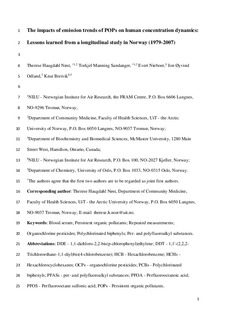| dc.contributor.author | Nøst, Therese Haugdahl | |
| dc.contributor.author | Sandanger, Torkjel M | |
| dc.contributor.author | Nieboer, Evert | |
| dc.contributor.author | Odland, Jon Øyvind | |
| dc.contributor.author | Breivik, Knut | |
| dc.date.accessioned | 2017-11-06T10:29:02Z | |
| dc.date.available | 2017-11-06T10:29:02Z | |
| dc.date.created | 2017-02-23T08:57:11Z | |
| dc.date.issued | 2017 | |
| dc.identifier.citation | Nøst, T. H., Sandanger, T. M., Nieboer, E., Odland, J. Ø., & Breivik, K. (2017). The impacts of emission trends of POPs on human concentration dynamics: Lessons learned from a longitudinal study in Norway (1979-2007). International Journal of Hygiene and Environmental Health, 220, 776-781. doi:10.1016/j.ijheh.2017.01.015 | nb_NO |
| dc.identifier.issn | 1438-4639 | |
| dc.identifier.uri | http://hdl.handle.net/11250/2464178 | |
| dc.description.abstract | Background. In this short communication, our focus is on the relationship between human concentrations of select persistent organic pollutants (POPs) and environmental emissions. It is based on a longitudinal study (1979-2007) conducted in Norway. Objectives. Our aim was to extract general insights from observed and predicted temporal trends in human concentrations of 49 POPs to assist in the design and interpretation of future monitoring studies. Discussion. Despite considerable decline for polychlorinated biphenyls (PCBs) and organochlorine pesticides (OCPs) since 1986, the sum of the targeted POPs increased from 1979 until 2001, with per- and polyfluorinated alkyl substances (PFASs) dominating recent blood burden measurements. Specifically, the time trends in serum concentrations of POPs, exemplified by PCB-153, 1,1'-(2,2,2-Trichloroethane-1,1-diyl)bis(4-chlorobenzene) (DDT) and perfluorooctane sulfonic acid (PFOS), resembled the trends in available data on their emissions, production or use. These observations suggest that interpretations of human biomonitoring data on persistent compounds must consider historic emissions, which likely vary spatially across the globe. Based on the different temporal trends observed across POP groups, it is evident that generalizations regarding temporal aspects have limitations. Conclusion. The discussion herein underscores the importance of understanding temporal variations in environmental emissions when designing and interpreting human biomonitoring studies. | nb_NO |
| dc.language.iso | eng | nb_NO |
| dc.rights | Attribution-NonCommercial-NoDerivatives 4.0 Internasjonal | * |
| dc.rights.uri | http://creativecommons.org/licenses/by-nc-nd/4.0/deed.no | * |
| dc.title | The impacts of emission trends of POPs on human concentration dynamics: Lessons learned from a longitudinal study in Norway (1979-2007) | nb_NO |
| dc.type | Journal article | nb_NO |
| dc.type | Peer reviewed | nb_NO |
| dc.description.version | acceptedVersion | nb_NO |
| dc.rights.holder | © 2017 Elsevier GmbH | nb_NO |
| dc.source.pagenumber | 776-781 | nb_NO |
| dc.source.volume | 220 | nb_NO |
| dc.source.journal | International journal of hygiene and environmental health | nb_NO |
| dc.source.issue | 4 | nb_NO |
| dc.identifier.doi | 10.1016/j.ijheh.2017.01.015 | |
| dc.identifier.cristin | 1453293 | |
| dc.relation.project | Norges forskningsråd: 213577 | nb_NO |
| dc.relation.project | Framsenteret: Unknown | nb_NO |
| dc.relation.project | Helse Nord RHF: Unknown | nb_NO |
| cristin.unitcode | 7460,60,0,0 | |
| cristin.unitcode | 7460,57,0,0 | |
| cristin.unitname | Miljøkjemi | |
| cristin.unitname | Atmosfære og klima | |
| cristin.ispublished | true | |
| cristin.fulltext | postprint | |
| cristin.qualitycode | 1 | |

